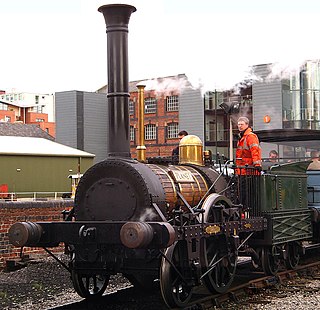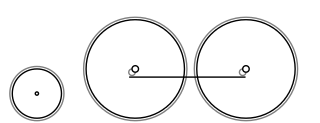
A Fairlie locomotive is a type of articulated steam locomotive that has the driving wheels on bogies. The locomotive may be double-ended or single ended. Most double-ended Fairlies had wheel arrangements of 0-4-4-0T or 0-6-6-0T.

0-6-0 is the Whyte notation designation for steam locomotives with a wheel arrangement of no leading wheels, six powered and coupled driving wheels on three axles, and no trailing wheels. Historically, this was the most common wheel arrangement used on both tender and tank locomotives in versions with both inside and outside cylinders.
The UIC classification of locomotive axle arrangements, sometimes known as the German classification or German system, describes the wheel arrangement of locomotives, multiple units and trams. It is used in much of the world, notable exceptions being the United Kingdom and North America.

4-4-0, in the Whyte notation, denotes a steam locomotive with a wheel arrangement of four leading wheels on two axles, four powered and coupled driving wheels on two axles, and no trailing wheels.

Under the Whyte notation for the classification of steam locomotives, 2-2-0 represents the wheel arrangement of two leading wheels on one axle, two powered driving wheels on one axle, and no trailing wheels. This configuration, which became very popular during the 1830s, was commonly called the Planet type after the first locomotive, Robert Stephenson's Planet of 1830.

Under the Whyte notation for the classification of steam locomotives, 0-10-0 represents the wheel arrangement of no leading wheels, ten powered and coupled driving wheels on five axles and no trailing wheels. In the United Kingdom, this type is known as a Decapod, a name which is applied to 2-10-0 types in the United States. In the United States, the type is known as ten-coupled.

In the Whyte notation for the classification of steam locomotive wheel arrangement, an 0-4-4-0 is a locomotive with no leading wheels, two sets of four driving wheels, and no trailing wheels. The arrangement is chosen to give the articulation of a locomotive with only the short rigid wheelbase of an 0-4-0, but with its weight spread across eight wheels, and with all the weight carried on the driving wheels; effectively a flexible 0-8-0. Articulated examples were constructed as Mallet, Meyer, BMAG and Double Fairlie locomotives and also as geared locomotives such as Shay, Heisler, and Climax types. A similar configuration was used on some Garratt locomotives, but it is referred to as 0-4-0+0-4-0. In the electric and diesel eras, the Bo-Bo is comparable and closest to the Meyer arrangement of two swivelling bogies.

An 0-2-2, in the Whyte notation for the classification of steam locomotives by wheel arrangement, is one that has two coupled driving wheels followed by two trailing wheels, with no leading wheels. The configuration was briefly built by Robert Stephenson and Company for the Liverpool and Manchester Railway.

Under the Whyte notation for the classification of steam locomotives, 2-4-0 represents the wheel arrangement of two leading wheels on one axle, four powered and coupled driving wheels on two axles and no trailing wheels. In most of North America it became known as a Porter.
Under the Whyte notation for the classification of steam locomotives, 0-12-0 represents the wheel arrangement of no leading wheels, twelve powered and coupled driving wheels on six axles, and no trailing wheels.
David Jones (1834–1906) was locomotive superintendent of the Highland Railway between 1870 and 1896. He was credited with the design of the first British 4-6-0, which was strongly influenced by the Scottish locomotive design for Indian Railways. The 4-6-0 wheel arrangement that appeared in 1894, quickly became the most common locomotive for main line passenger and mixed traffic work in Britain.

Under the Whyte notation for the classification of steam locomotives, 0-8-4 represents the wheel arrangement of no leading wheels, eight powered and coupled driving wheels on four axles, and four trailing wheels on two axles.
Tralee and Dingle Light Railway 7 and 8 were two 2-6-0T locomotives manufactured by Kerr, Stuart and Company in 1902 and 1903 for the Tralee and Dingle Light Railway.

Under the Whyte notation for the classification of steam locomotives by wheel arrangement, the 0-4-0+0-4-0 is an articulated locomotive of the Garratt type. The wheel arrangement is effectively two 0-4-0 locomotives operating back-to-back or face-to-face, with the boiler and cab suspended between the two power units. Each power unit has no leading wheels, four powered and coupled driving wheels on two axles and no trailing wheels. A similar arrangement exists for Mallet, Meyer and Fairlie locomotives, but is referred to as 0-4-4-0.
During the 1880s and 1890s, William Dean constructed a series of experimental locomotives to test various new ideas in locomotive construction for the Great Western Railway.
Under the Whyte notation for the classification of steam locomotives by wheel arrangement, a 4-4-2+2-4-4 is a Garratt articulated locomotive. The wheel arrangement is effectively two 4-4-2 locomotives operating back to back, with each power unit having four leading wheels on two axles in a leading bogie, four powered and coupled driving wheels on two axles, and two trailing wheels on one axle in a trailing truck. Since the 4-4-2 type is usually known as an Atlantic, the corresponding Garratt type is often referred to as a Double Atlantic.
A compound locomotive is a steam locomotive which is powered by a compound engine, a type of steam engine where steam is expanded in two or more stages. The locomotive was only one application of compounding. Two and three stages were used in ships, for example.
Under the Whyte notation for the classification of steam locomotives, 2-2-2-0 usually represents the wheel arrangement of two leading wheels on one axle, four powered but uncoupled driving wheels on two axles, and no trailing wheels, but can also be used to represent two sets of leading wheels two driving wheels, and no trailing wheels. Some authorities place brackets around the duplicated but uncoupled wheels, creating a notation 2-(2-2)-0, or (2-2)-2-0, as a means of differentiating between them. Others simply refer to the locomotives 2-2-2-0.
A divided drive locomotive is a steam locomotive that divides the driving force on its wheels by using different cylinders to power different pairs of driving wheels in order to give better weight distribution and reduce "hammer blow" which can be damaging to the track, or else to enable the wider spacing of the driving wheels to accommodate a larger firebox.

A 2-4-6-2 steam locomotive, in the Whyte notation for describing locomotive wheel arrangements, has a two-wheel leading truck, one set of four driving wheels, one set of six driving wheels, and a two-wheel trailing truck.













